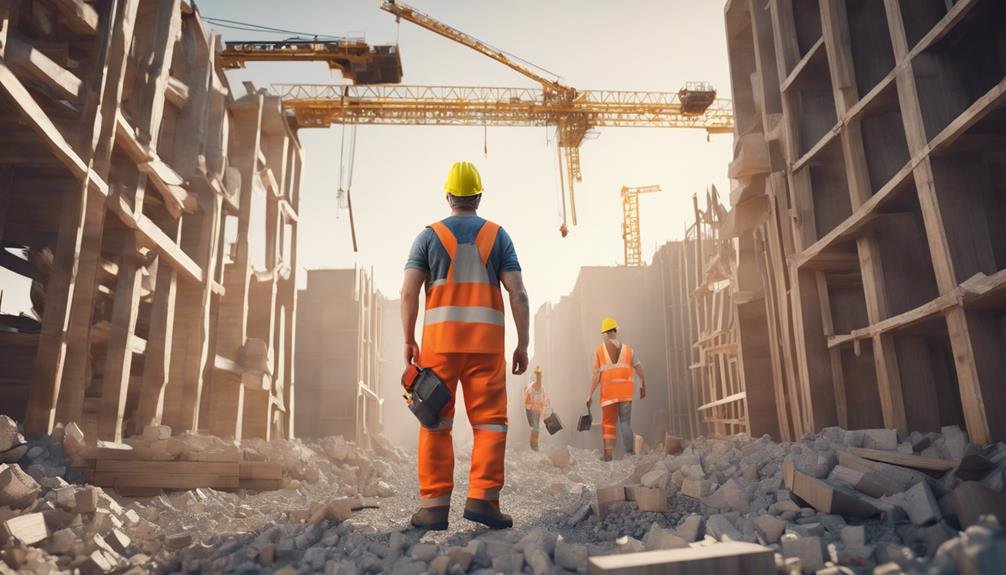Dealing With Difficult People and Situations in Construction
When dealing with difficult people and situations in construction, recognize toxic behaviors affecting productivity. Watch for negativity, gossip, and undermining. Maintain professionalism with aggressive clients and communicate clearly to prevent conflicts. Guarantee concise instructions, practice active listening, and simplify tasks. Use visual aids for clarity and define expectations clearly. Employ active listening for conflict resolution, focus on collaboration, and encourage mutual respect. Manage client expectations by setting boundaries early and addressing concerns promptly. Establish proactive approaches to address project delays and prioritize safety protocols. For building resilience, handle challenges effectively and foster a culture of collaboration.
Key Takeaways
- Recognize toxic behavior hindering productivity.
- Address aggressive clients with calm professionalism.
- Implement mediation, negotiation, and compromise.
- Foster a culture of collaboration and mutual respect.
- Maintain clear communication to mitigate conflicts.
Recognizing Difficult Personalities
Recognize difficult personalities by observing consistent patterns of behavior that hinder productivity and teamwork on construction sites. Identifying toxic behavior is vital in maintaining a positive work environment. Toxic behavior can manifest in various ways, such as constant negativity, gossiping, or undermining colleagues' work. Keep an eye out for individuals who exhibit such behaviors regularly, as they can have a detrimental impact on the overall morale and efficiency of the team.
Handling aggressive clients is another aspect to take into account when dealing with difficult personalities in construction. Aggressive clients may exhibit behaviors like frequent outbursts, unreasonable demands, or disrespect towards the project team. It's essential to approach such situations with a calm and professional demeanor. Listen actively to their concerns, acknowledge their feelings, and try to find mutually beneficial solutions. Setting boundaries and maintaining clear communication can help mitigate conflicts with aggressive clients and make sure that the project progresses smoothly. Stay vigilant for signs of toxic behavior and be proactive in addressing them to foster a harmonious work environment.
Effective Communication Strategies
To effectively communicate with difficult personalities in construction, guarantee your instructions are clear and concise, leaving no room for misinterpretation.
Practice active listening to demonstrate understanding and validate the concerns of others, fostering a more collaborative environment.
Clear Instructions for Clarity
When giving instructions in construction projects, make sure that they're clear and concise to avoid misunderstandings and errors. Simplifying tasks is essential for effective communication on-site. Begin by breaking down complex tasks into smaller, more manageable steps.
Use straightforward language and avoid technical jargon that may confuse team members. Enhancing communication involves being specific about expectations and deadlines. Clearly state what needs to be done, by whom, and by when.
Visual aids like diagrams or sketches can also aid in conveying information more clearly. Encourage questions to ensure everyone understands the instructions fully.
Active Listening for Understanding
In order to foster effective communication and promote mutual understanding, actively engaging in listening skills is crucial when managing intricate construction projects. When dealing with difficult people or situations in construction, practicing empathy and active listening can help break down communication barriers.
Here are some key strategies to improve your active listening skills:
- Maintain eye contact and nod to show you're listening attentively.
- Paraphrase and summarize what the other person is saying to guarantee understanding.
- Ask clarifying questions to get a clearer picture of the issue at hand.
- Avoid interrupting and truly focus on the speaker's words to demonstrate respect and attentiveness.
Conflict Resolution Techniques
When dealing with difficult individuals in construction, it's important to employ active listening skills to understand their perspectives fully.
By practicing collaborative problem-solving techniques, you can work together to find mutually beneficial solutions.
These conflict resolution techniques can help foster better relationships and smoother project outcomes.
Active Listening Skills
To effectively resolve conflicts with difficult people in construction, hone your active listening skills. Active listening involves not only hearing but understanding the speaker's perspective. Here are some tips to help you improve your active listening skills:
- Practice empathy training to better understand the emotions and thoughts behind the speaker's words.
- Avoid interrupting or planning your response while the other person is speaking to prevent communication breakdowns.
- Focus on the speaker's non-verbal cues, such as body language and tone of voice, to grasp the full meaning of their message.
- Recap or paraphrase what you've heard to make sure you've understood correctly before responding.
Collaborative Problem-Solving
Enhance your conflict resolution skills by implementing collaborative problem-solving techniques in construction projects. In team dynamics, conflicts can arise due to differing opinions, tight deadlines, or resource constraints.
To address these challenges effectively, it's important to foster a collaborative environment where all team members feel heard and valued. By promoting open communication and active participation from all stakeholders, you can create a space for constructive dialogue and problem-solving.
Conflict resolution techniques such as mediation, negotiation, and compromise play an essential role in resolving disagreements and moving the project forward. Encouraging a culture of collaboration and mutual respect within your construction team can lead to smoother project execution and improved overall outcomes.
Managing Client Expectations
Managing client expectations is crucial in construction projects to guarantee clear communication and successful outcomes. When it comes to dealing with clients, setting boundaries and maintaining trust are key elements to make sure a positive working relationship.
To effectively manage client expectations, consider the following:
- Establish Clear Communication Channels: Regularly update clients on project progress, changes, and any potential delays to align expectations and avoid misunderstandings.
- Define Scope and Deliverables Early: Clearly outline the project scope, timeline, and deliverables at the beginning to manage client expectations regarding what'll be accomplished.
- Address Concerns Promptly: Be proactive in addressing any client concerns or questions to maintain trust and prevent issues from escalating.
- Manage Change Requests Effectively: Establish a process for handling change requests to keep clients informed about the impact on timelines, budgets, and project scope.
Dealing With Project Delays
Establishing a proactive approach to addressing project delays is key to guaranteeing successful construction outcomes. Time management plays a vital role in mitigating project delays. Create detailed schedules that outline tasks, milestones, and deadlines to help track progress effectively. Regularly review and adjust these schedules as needed to stay on track and identify potential delays early on.
Resource allocation is another critical factor in dealing with project delays. Make certain that resources such as materials, equipment, and labor are allocated efficiently and effectively. Lack of proper resource planning can lead to delays due to shortages or bottlenecks. Regularly monitor resource usage and make adjustments as necessary to prevent delays caused by resource constraints.
Addressing Safety Concerns
To guarantee a safe work environment in construction, prioritize regular safety inspections and training sessions for all personnel involved in the project. When addressing safety concerns, follow these key steps:
- Safety Protocols: Establish clear safety protocols that outline procedures in case of emergencies, such as fires or accidents.
- Hazard Identification: Conduct thorough hazard identification assessments to pinpoint potential risks on the construction site.
- Training Programs: Implement detailed training programs that educate workers on safety measures and best practices.
- Regular Inspections: Schedule frequent safety inspections to confirm that equipment and work areas meet safety standards.
Building Resilience in Construction Industry
Building resilience in the construction industry involves adapting to unforeseen challenges and fostering a culture of proactive problem-solving among all team members. Stress management plays an essential role in enhancing resilience. Encouraging open communication channels can help team members express concerns and seek support when feeling overwhelmed. Implementing stress-relief activities or providing access to resources like counseling can aid in maintaining a positive work environment.
Team dynamics also play a vital role in building resilience. Establishing strong relationships among team members fosters trust and collaboration. Encouraging teamwork and mutual respect creates a supportive atmosphere where individuals can rely on each other during tough times. Conducting team-building exercises or regular check-ins can strengthen these dynamics and enhance overall resilience within the construction team.
Conclusion
To sum up, maneuvering through challenging people and situations in construction can be a delicate dance. By identifying difficult personalities, practicing effective communication, utilizing conflict resolution techniques, managing client expectations, addressing safety concerns, and building resilience, you can successfully overcome obstacles and keep your projects on track.
Remember, each obstacle is simply an opportunity for growth and improvement in the construction industry. Keep pushing forward and you'll conquer any difficulty that comes your way.







